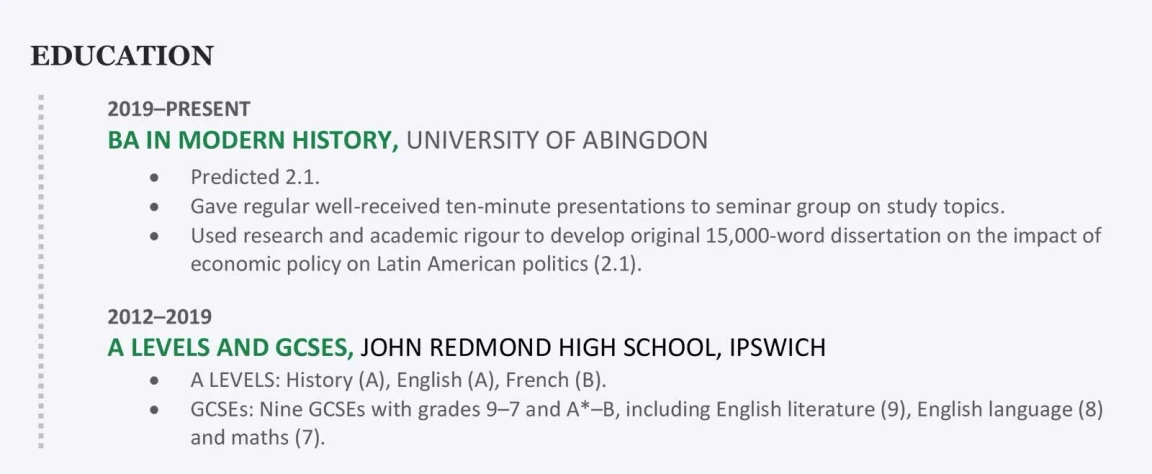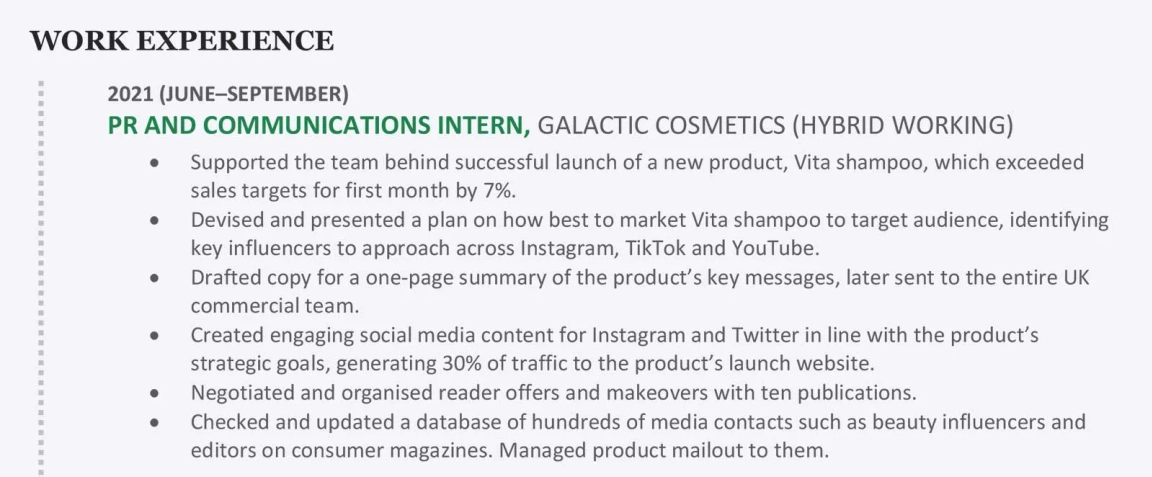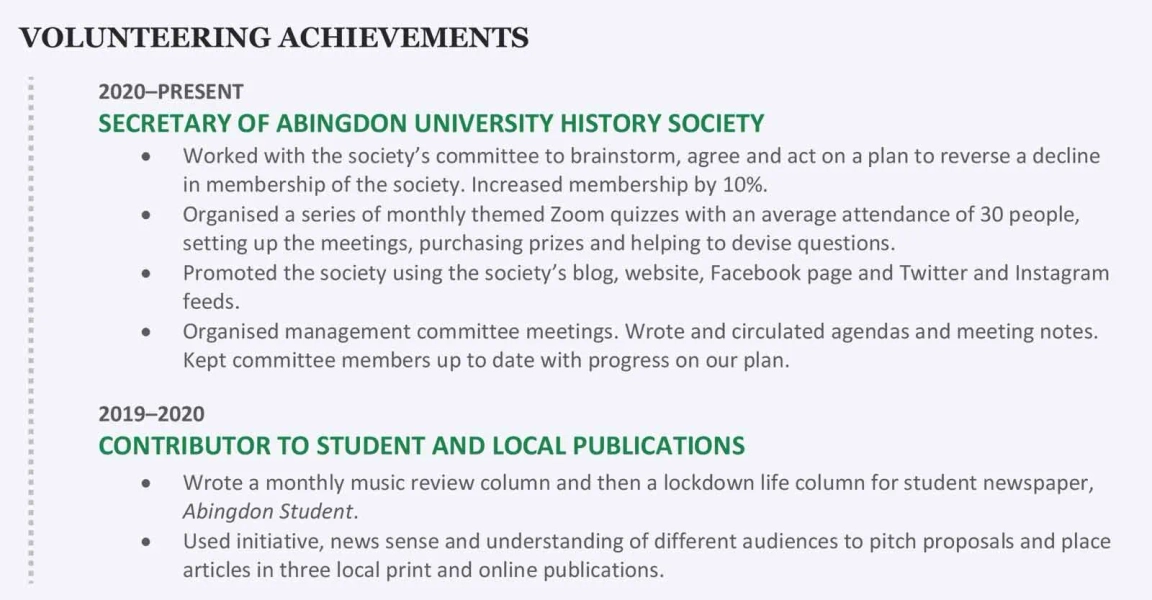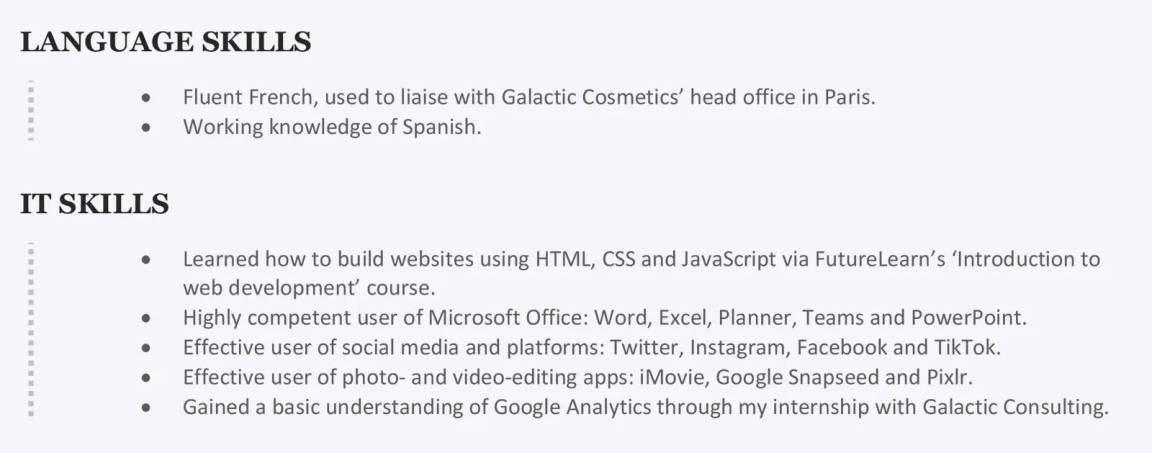Applications
The big guide to CV writing: make our template your own
20 Aug 2025, 08:39
Our in-depth guide to writing and structuring your CV will take you through each section of our classic graduate CV template and explain how to use the format to showcase your strengths.

CV template introduction | More CV advice | The opening of your CV and your contact details | The personal statement or profile | Education | Work experience | Volunteering | Further interests | Language and IT skills | References | CVs for different graduate professions
The only hard and fast rule for writing CVs is that there are no hard and fast rules. Your CV will be shaped by your personal experience, qualifications and skills, and it will grow and change with you. You also need to tailor it for each job application so that it highlights the qualities the employer is looking for. Overall, your CV should tell a compelling story about your motivation to succeed in that particular job with that employer in that profession or career sector.
We’ve put together a classic CV template to help you get started and this article will take you through each section of the example layout to explain why it has been put together in this way and give you options to consider for your own CV.
Graduate CV template
Getting ready to apply for a graduate programme or an entry-level job? Check out our example CV.
Want more than the template? More CV advice
We’ve got every angle of CV writing covered. Make sure you use this guide to the template alongside our basic and advanced CV advice.
- Want to check up on the basics first? Read our responses to frequently asked questions about font size, length, format and other aspects of CV layout and design that help your CV make a good first impression.
- Take a look at our advanced masterclass on perfecting your graduate CV for six tips on how to step back from the template and polish your CV, so you can compete effectively for the job you want.
- Want to know more about different approaches to CV writing? Our quick guide to chronological, skills-based and combination CVs sets out some options. Our CV template takes a chronological approach because that’s particularly useful for most students, as they are less likely to have extensive work experience. But if that’s not the case for you, you might want to organise your CV to focus more on your skills.
- This article is focused around our main CV template designed for final-year students and graduates, but you can also take a look at our other example CVs, including resumés for internship, technical, law and investment banking vacancies.
The opening and your contact details

You don’t need to include the words ‘Curriculum Vitae’, or your age, gender or date of birth.
You don’t need to include a photo with your CV. This is not standard practice in the UK. However, it is sometimes a requirement in other countries.
You should put your contact details first, but can put the other sections in the order you feel works best to showcase your suitability for the job.
Make sure that any contact details you include work and that email addresses sound professional. You could include your LinkedIn profile here. If you do, make sure it’s up to date and reflects the information given in your CV. For some roles in areas such as marketing, advertising or journalism, you could include links to your blog, website or social media feeds (as long as they are up to date). Remember that employers are likely to check any links you add to your CV.
Should you start with a personal statement, profile or key achievements section?
Our graduate CV template does not include a personal statement (sometimes also known as a profile, career aim or mission statement) or key achievements section because we do not believe this is essential, particularly at this early stage in your career. The risk is that a profile or personal statement can come across as generic, bland and waffly, and employers may find them off-putting. If you really feel that your CV needs an introduction, we suggest a brief Key achievements section, as this is more likely to be focused and succinct, and provide the kind of concrete detail that employers like.
However, if you are writing a CV that will not be accompanied by a covering letter or application form (or both) ¬– for example, to upload to a jobs board or to apply for a role via LinkedIn – a personal profile could be a useful way to introduce yourself.
Keen to find out more about how to craft a strong profile statement and what to avoid? Make sure you tailor it to the job. Go to our personal statement advice for more tips.
Your education

You could use Education and qualifications as a heading for this section.
Make sure you follow any instructions about which qualifications and grades to list. The employer may want graduates from specific degree backgrounds for the graduate scheme or job you are applying for, or may have requirements relating to degree class or A level subjects or grades. Here’s where you show you fit the bill.
If you haven’t yet completed your degree, make it clear that you are including a predicted result.
List key details relating to your education in reverse chronological order (most recent first).
How much detail should you go into about your degree? It depends on the role you are applying for. You don’t need to explain what you studied unless it’s relevant to the job. This is particularly likely in technical roles, for example in engineering and IT. Modules that show numerical ability could be relevant for a range of jobs, including in finance. If you do mention particular modules, say what mark you got for them. Good marks in relevant modules will strengthen your application.
If you want to flag up a module that will be of interest to the employer but you haven’t got your final mark yet, state that you’re still studying it.
Some employers in some professions, such as law, place a very high value on academic ability and achievement. This could make it particularly relevant to give details of good marks that show you’re the kind of candidate they want.
You could include details of academic prizes or awards in the section about your education, or put them in an achievements section elsewhere in your CV.
In our graduate CV template, our fictious candidate has not included her degree modules because she judged them not relevant to the job she is applying for, but she has included evidence of her presentation skills. If you turn to our example technical CV, you can see an example of how to write up your degree module results.
It is standard to include your grades for A levels, qualifications such as Scottish Highers and Advanced Highers and BTEC qualifications at level 3. However, you don’t need to include grades for individual GCSEs or equivalent qualifications at this stage unless you have been explicitly asked to. Nor should you include individual grades for GCSEs or equivalent qualifications when you are applying for internships. It’s better to group them together.
Your work experience or employment history

There are different ways you could divide up your work experience and employment history, and different titles you could use for the information. In our CV template we’ve gone for Work experience, but our imaginary applicant could have opted for more focused headings around the areas covered by her work experience, such as having a Marketing and business experience for her PR and consulting experience and a Customer service experience for her retail and telesales jobs (assuming that she’s applying for a job where having experience in this area will strengthen her application).
Some CV templates divide experience up into Relevant employment and work experience and Other employment and work experience, but we recommend looking at ways to make all the information you include appear relevant.
If you have a career-specific work experience section and your extracurricular activities or positions of responsibility also fit in with this career area, you could fold them in together. For example, if you were applying for a media job, you could put editing your student newspaper in the same section as any publishing internships you’ve undertaken. Alternatively, you could include positions of responsibility under a separate heading, or cover them under a heading such as Awards and achievements or (if they are voluntary) Volunteering.
List your work experience or employment in reverse chronological order (most recent first).
When you are giving details of the skills you developed in a job, internship or work experience placement, you don’t need to say explicitly ‘Skills developed’ – that’s obvious, and uses up precious space.
Try to match the competencies in the job description and give examples of the most relevant skills first.
It’s good to be specific and precise in the examples you give of your skills. This could mean avoiding broad, standard terms such as communication and teamwork, and trying to define your skills more closely; for example, you might refer to negotiating, persuading, or influencing. However, it’s a good idea to reflect any skills explicitly listed in the job information.
You don’t have to use bullet points, but they can help. Keep them snappy – not longer than two lines. They’re meant to be a concise way of conveying information.
Employers love evidence. They don’t just want to be told how great you are; they want you to show them. So give concrete examples and quantify your impact where possible. This could involve saying how frequently you carried out a task, or giving a numerical income. If you worked as part of a team, try to indicate what you contributed. If you proposed an idea, say briefly what it was, whether it was implemented and what the impact was. (If the idea wasn’t acted on, or didn’t work out, you might decide not to include it, or you might need to describe it carefully so as to show what you learned from the experience.)
Don’t omit your part-time jobs in retail or catering because you’ve assumed graduate employers won’t be interested. They show real-world experience and an ability to keep on showing up on time even when work is routine or repetitive. That means resilience, a quality employers prize. Remember the recruiter might well have done similar work once upon a time. You can include jobs that are very similar in a cluster or grouping if you like, if there aren’t different details that you could usefully pick out to include about each role.
Alison Thorpe, our made-up CV candidate, had some stand-out achievements in her retail and telesales jobs (see below), but what if you are struggling to think of ways to describe what you did so that it will impress an employer? Here are some tips to help you highlight what you have got out of your holiday or part-time experience of retail or bar jobs:
- Use confident language to convey your skills. Drawing attention to awards or praise employers give you is a good way to do this.
- If you took on a role such as deputising for a senior colleague, give a brief description of what was involved.
- Give brief details of systems you used.
- Including information about your performance and targets helps to quantify your impact.
- It’s better to focus on transferable skills, such as being tactful with awkward customers, than to describe routine tasks.

Your CV is all about balance. With limited space available, you may choose to keep the information about your part-time jobs relatively brief, and go into more detail about an internship, volunteering achievements or extracurricular activities that have given you more scope to develop the kind of skills the employers seek.
Volunteering achievements

Alternative headings for this section include: Positions of responsibility, Awards and achievements, Additional experience or Volunteering.
This is where your CV moves on to extracurricular activities. The sort of information you are likely to cover here will include your involvement in student societies and organisations, sports and volunteering.
You can structure the information you give about your positions of responsibility or volunteering achievements in a similar way to your work experience. Where possible, quantify your impact.
You might also have a Further interests or Interests section that gives more information about your life outside of education and employment, or you might decide that everything that is relevant has been covered in your information about positions of responsibility.
If you mention travelling, highlight aspects of your travels that have developed skills relevant to the job you are applying for, such as how you approached raising funds for it.
By the time you’re in your final year and applying for graduate roles employers are unlikely to be interested in positions of responsibility from your school days, so as a general rule you should not include these. However, you might decide to make an exception if you want to flag up an achievement that is particularly outstanding or highly relevant to the job and employer.
Further interests
We’ve chosen not to include further interests in our template CV because our imaginary job hunter has put the relevant information into the previous section.
This is one of the grey areas of CV writing, however. Some recruiters like to see a range of interests and are happy to see this section included. For that reason, we’ve included an interests section in our technical CV template.
If you do include further interests, avoid listing hobbies such as socialising with friends. Unusual or team sports, volunteering and overseas expeditions can all help to give the recruiter a sense of who you are and can all be well worth including. Throat singing? Fencing? Mountaineering? Whatever you choose to include, and however obscure or specialist it is, be prepared to discuss it in more detail, as you might find yourself being interviewed by somebody who shares the same interests.
Read more on how to make the most of a further interests section on your CV.
Language and IT skills

Alternatively, you could have a section on Skills, Skills and interests, or Additional skills.
In our CV template we’ve chosen to separate out language skills and IT skills, to give them a bit more space and because both are relevant to the imaginary employer and the role being applied for.
If you include languages, describe your level of competence. You could illustrate this with an example of a time when you’ve used your language skills at work or in your extracurricular activities, or with a score for your language speaking if you have one. Don’t include a section on languages if you only speak your native language.
Depending on the role you’re applying for, you might want to make much more of your IT skills than we have done here and feature it in a more prominent location. Our example technical CV includes a section on technical skills at the beginning, with sections on Projects and hackathons and Online courses later on.
References
You can save space by saying ‘References on request’, or omit this line altogether as it can safely be assumed that you’ll provide referees’ details if you are offered a job.
CV advice for different graduate jobs
- Engineering CV template and adviceInsurance and financial services CV tipsInvestment banking CV advice and templateCV template and tips for IT technology jobsLaw CV template and tipsCV tips for management jobs and leadership graduate programmesCV examples and tips for marketing, advertising and PR jobsCV and covering letter advice for media and journalism jobsCV tips for jobs in salesCV advice for travel and tourism jobs
targetjobs Editorial advice
This describes editorially independent and impartial content, which has been written and edited by the targetjobs content team. Any external contributors featuring in the article are in line with our non-advertorial policy, by which we mean that we do not promote one organisation over another.






